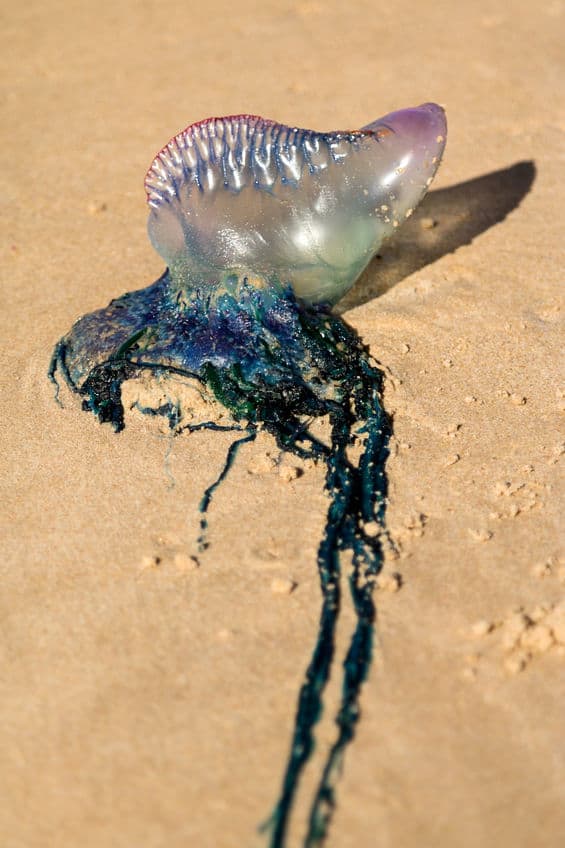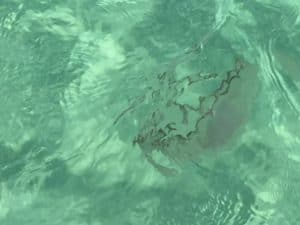Probably a close second to the fear of sharks, one of the biggest fears of swimming in salt water is encountering a jellyfish. One sting from a jellyfish that packs a punch (or knowing someone who has gotten stung) can cause anxiety.
So what types of jellyfish are found in Destin? While some are more prevalent than others, the primary jellyfish that have been spotted in the Destin area include:
- Cannonball jellyfish
- Mushroom jellyfish
- Moon jellyfish
- Sea Nettle jellyfish
- Pink Meanie jellyfish
- Man of War
Cannonball Jellyfish
Cannonball jellyfish (or some call them Cabbage Head jellyfish) look just like either name suggests: they are round with a fluffy, cabbage-like bottom. Their bodies are milky with pink-to-brownish around the edges. They do have some venom, but not enough to go through the skin to affect people.
These are an important part of the ecological system here, as the Cannonball jelly is a favorite of the sea turtles that use the beaches here for a nesting spot.
Mushroom Cap Jellyfish
The Mushroom jelly is similar in shape and size to the Cannonball jellyfish, but has a steeper curve on the sides with more of a frilly edge at the bottom. It is milky with possibly pink, orange and brown highlights. It has off-shoots at the bottom which may look like fat tentacles, but they’re actually the feeding mechanism of this jellyfish. Similar to the Cannonball, it doesn’t really affect humans.
Moon Jellyfish

Moon jellyfish are very common in this area. They appreciate brackish water; these are a common jelleyfish at Crab Island so depending on the time of year, you may see a few of these. You’ll need to look closely in the water though. While the center of their body could have a little pink color, they typically are clear with milky edges. They are distinguishable because of their 4-leaf clover pattern in the center of the body. They range in size with some getting a foot or so big, but most of the ones we’ve seen have been sand dollar-size or slightly smaller or larger.
They have a very mild sting in people, so usually they just produce an irritation that might last up to ½ hour.
Sea Nettle Jellyfish

The Sea Nettle jellyfish found in the Gulf is the Atlantic Sea Nettle. It has an umbrella-shaped body that can reach 6 inches across. It as tentacles that can several feet in length. They do sting, although it’s milder than the ones below.
The Destin area is a perfect spot for Sea Nettles because these jellies tend to like less-salty water, just like the water in the Choctawatchee Bay.
(Reference: Aces.edu)
Pink Meanies
The Pink Meanie jellyfish is aptly named. It’s powerful sting enables it to easily fish for prey… which includes eating other Pink Meanies!
These jellies get larger than others, ranging in the neighborhood of 3 feet in diameter when measuring the body.
They were found in the Gulf of Mexico back in 2000, but were thought to be a jellyfish that migrated from the Mediterranean Sea. A little over ten years later, with the help of new genealogy technology, scientists classified it as its own family of jellyfish; this was the first time that new family was named since the early 1900s.
The Pink Meanie tentacles can reach up to 70 feet long.
(Resource: AL.com)
Man of War
Portuguese Man of War is well known for the wallop that “its” sting delivers. “Its” is in quotations because the Man of War, also known as Bluebottle, is not really an “it” at all. Each Man of War is a grouping of organisms that congregate to form a colony, performing together for survival.

Each Man of War has a top section which can be inflated, similar to a balloon, which allows them to float on the surface, catching wind to propel them, since they don’t have way to propel themselves in the water. Their tentacles can be a scary sight, usually reaching up to 30 feet, but can actually reach 165 feet in length.
They use their venomous tentacles to paralyze fish and other prey and then they use them to slide their prey up to the main body to be consumed. If they need to, they can deflate their balloon-like “sail,” to submerge for short periods to avoid possible danger on the surface.
What’s the Best Way to Immediately Treat a Man of War Sting?
While it seems that the scientific community varies in their recommendations for a Man of War sting, a study published in 2016 which looked at a number of assays and compared potential remedies found that removing tentacles by applying vinegar and hot water for 45 minutes is one of the best immediate ways to relieve the pain. (This study found “Sting No More” was the best method to quickly notice relief.) (1)
These do sometimes wash up on shore, and while they’re interesting to look at, be careful. They can still deliver a sting.
(Reference: National Geographic)
What is Jellyfish Season in Destin?
When I asked a marine biologist friend of mine about the scientific answer to the jellyfish season in Destin, he said it really can go from May through October. However, higher numbers of jellyfish tend to show up in the Destin area around mid-summer (July), and can be seen there until the waters start to cool in September/November. Even during the colder winter months you may happen to see one, but they’re not as plentiful here during the colder months.
How Do You Know If There Are Jellyfish in the Destin Waters?
From late spring through early autumn, lifeguards are located at every station on the beach. They use a colored flag system to let the public know of the conditions of the water regarding currents and dangerous marine life. Purple is the color they use to let the public know that there is dangerous marine life in the area; most often the purple indicates jellyfish have been spotted.
If you’re somewhere where there aren’t lifeguard stations (like at Crab Island or in the Gulf, just stay alert and keep your eyes on the water. Often, you can see them, depending on the tide.
Here are two volleyball-size jellies we saw at Crab Island. (It was September when these pictures were taken.) There were hundreds of them! The good news is that you can often see them coming. Also, while they do have stingers, they’re very short and usually don’t hurt much.
Conclusion
As vacationers and locals wanting to enjoy the beautiful waters in the Destin area, jellyfish can cause anxiety and be a nuisance. However, most produce mild stings to people. And it’s important to remember that they are an important part of the marine life cycle to this part of the coast.
Have you had an interesting jellyfish sighting? We’d love to hear about it!


